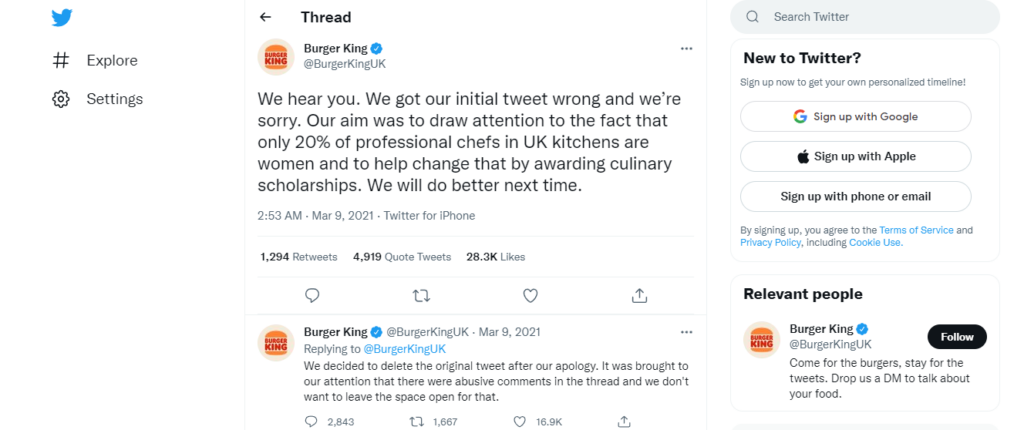How to Create a Social Media Crisis Management Plan
Every business – successful or struggling – needs a social media crisis management plan. The best social media crisis management starts long before any issue arises.
The best social media crisis management starts long before a problem occurs. Any kind of crisis can hit your brand at any time. The last few years have been a wake-up call for many brands. According to PwC’s 2021 Global Crisis Survey, only 23% of US companies reported having a dedicated crisis response team at the start of the pandemic. Still, 62% of companies used a crisis response plan during the pandemic.
Even the trolliest of trolls can be withstood if you plan for the worst before it happens. Have a well-thought-out plan in place, including a list of important players, their roles, and the chain of command. If worst comes to worst, you’ll be prepared to salvage the reputation of your company. Moreover, you can also take the help of social media tools to solve the crisis.
In this article, we’ll discuss how to handle the consequences when your good reputation is damaged. Let’s first begin with what is social media crisis.
What does Social Media Crisis Mean?
Any activity on social media platforms that might negatively affect the reputation of your brand is considered a social media crisis. A social media crisis occurs when there is a significant shift in the discussion about your brand on social media as a result of an event that has stoked widespread resentment, disappointment, or mistrust.
Let’s have a look at social media crisis examples:
Burger King posted an insensitive tweet on Women’s day

Although their campaign was designed to draw attention to the underrepresentation of women in the restaurant industry, it failed badly.
Red Bull had to pay $13 million to settle a false advertising class action suit

Benefits of Social Media Crisis Management
Social media is a powerful tool that can help you in responding well to clients or detractors. It can help you manage the crisis by pursuing them. Let’s have a look at why crisis management is important:
- You can communicate with almost all of your customer base using social media on one or more platforms. Around 90% of business marketers believe that their business has experienced good exposure because of social media. When a crisis arises, your business can quickly broadcast a message and move ahead.
- Using direct messaging or comments, you can communicate with customers on social media directly. Your customer service team can reply to a single customer’s concern instantly via a private or public message. An efficient response from your customer service team can serve as a good example of your team’s credibility if the customer posts publicly on your timeline.
How to Create an Effective Social Media Crisis Management Plan
A proper response strategy for your social media channels is essential for handling everything from backlashing comments to natural disasters. Let’s delve into the steps to create a crisis management plan:
Identify the source of the problem
Finding the issue and its source is the first step in creating a social media crisis response. Every social media crisis does not originate online. A social media uproar frequently follows a news event or popular culture phenomenon. Understanding the crisis’s root cause will help you choose the best course of action and distribution for your response.
Respond promptly
Organizing your workflow is important. How you choose to respond makes all the difference. Quick social media responses help in creating long-lasting relationships. Impossibly, ignoring the issue won’t make it go away. And the better your reaction time, the faster. After all, even in the best of circumstances, over 75% of customers expect brands to respond to their complaints or negative comments within 24 hours. Being responsive is even more crucial when a crisis is present.
That might just entail promptly deleting the offending post, or it might entail making sincere repentance or apology. Whatever the solution, acting quickly is always preferable because delaying only gives the issue more time to worsen.
Burger king deleted its post within a few hours of posting it and issued an apology tweet.

Have a communication plan
Create a social media crisis communication plan if you don’t have one. This is something you should create when things are going well so you can respond rationally and practically in a social media emergency. Use the best social media marketing tools as a part of your communication strategy.
Practice social listening
Know what to share and when to stop? We can’t carry on as if nothing is wrong during a crisis. As a social media professional, it’s essential that you are clued up about the operations, strategies, and policies of your organization so that you can communicate with your audience clearly and empathically even when circumstances change on an hourly basis.
Instead of debating how to handle things or waiting for senior managers to weigh in, you’ll be able to react quickly to any potential issue if you have this document ready to go.
Apologize if its the need of the hour
It makes sense to want to return to “normal” as soon as possible if you find yourself in social media crisis management mode. An apology, however, is one aspect of a crisis that you should take your time with.
Many customers vowed to boycott Procter & Gamble (P&G) after the company shared a post saying that women’s feet smelled “five times worse than men’s.” P&G later deleted the message after issuing an apology for the remarks and admitting the consequences of their improper conduct.
Social Media Crisis Management Tips for Businesses and Brands
Social media crisis usually comes in the form of incessant customer Tweets over a service issue, or it could be a poorly timed or insensitive social media post from your brand. Use a small leadership team to triage the situation in the case of a crisis, carry out any necessary brand social media responses, and keep teams updated. Here are some tips that can cover you during the time of a crisis:
1. Get your team together
As each employee is vital, all of them can be on your crisis management team, depending upon your requirements. Yet, assemble a team of responsible first responders, each with a specific responsibility. To effectively implement decisions, management must coordinate, and content writers must carefully craft the desired message.
2. Keep the internal communication moving
Just like external communication, rumors and false information can spread quickly. Internal communication should be a part of your crisis communication strategy. This reduces stress and uncertainty and keeps everyone on the same page.
3. Put scheduled posts on pause
You must forget that you have a long social queue when a mad panic is breaking out all around you. You simply can’t afford to post “Happy #ThrowbackThursday — Have a beautiful day” accidentally after your product just generated a significant backlash.
4. Be sympathetic while speaking with commenters
Your initial response has been posted. You’re putting more thought into your messaging, and you plan to include a formal statement or video from the CEO. However, you must also work on this crisis’ front lines. and that entails reading through online mentions or entering the comment section. Don’t disregard the insults. Engaging the public is essential to demonstrate that you value their feedback and are attentive to their concerns. But keep it brief, and avoid arguing at all costs.
5. Monitor what people say about your company
You must head off every potential crisis before it grows and reaches entirely new audiences on social media. Take the help of social listening tools.
Start preparing now!
The good news is that a social media crisis may present an opportunity to strengthen your brand. You must be ready and maintain composure when a crisis arises in order to manage social media effectively.
Keep in mind the phase of crisis management before social media. You’ll gain some time in the initial stage if you’re ready for a social media crisis. This time can be used to get ready for the next stage of social media crisis management. Keep your composure during the crisis and interact with your supporters. Give your side of the story and make an effort to calm the tensest arguments in private communication.
The post How to Create a Social Media Crisis Management Plan appeared first on noupe.
